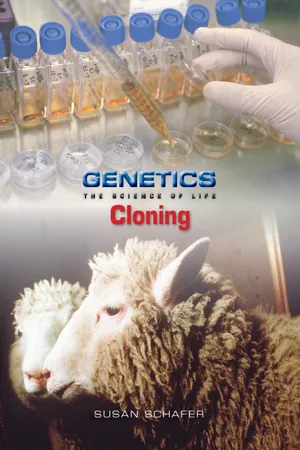
This is a test
- 88 pages
- English
- ePUB (mobile friendly)
- Available on iOS & Android
eBook - ePub
Cloning
Book details
Book preview
Table of contents
Citations
About This Book
This book provides in-depth explorations of genetic cloning, including the history of cloning and the types of artificial cloning for both plants and animals, with fascinating examples. It also explains the possibility of using the gene therapy to cure diseases.
Frequently asked questions
At the moment all of our mobile-responsive ePub books are available to download via the app. Most of our PDFs are also available to download and we're working on making the final remaining ones downloadable now. Learn more here.
Both plans give you full access to the library and all of Perlego’s features. The only differences are the price and subscription period: With the annual plan you’ll save around 30% compared to 12 months on the monthly plan.
We are an online textbook subscription service, where you can get access to an entire online library for less than the price of a single book per month. With over 1 million books across 1000+ topics, we’ve got you covered! Learn more here.
Look out for the read-aloud symbol on your next book to see if you can listen to it. The read-aloud tool reads text aloud for you, highlighting the text as it is being read. You can pause it, speed it up and slow it down. Learn more here.
Yes, you can access Cloning by Susan Schafer in PDF and/or ePUB format, as well as other popular books in Politics & International Relations & Politics. We have over one million books available in our catalogue for you to explore.
Information
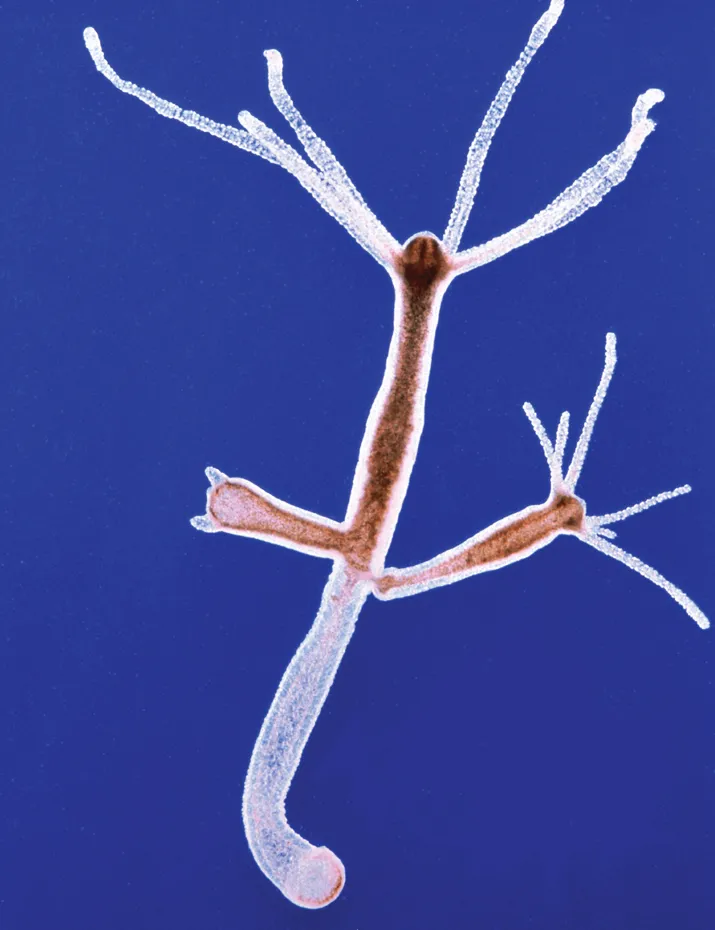
Tiny aquatic animals called hydra reproduce asexually by a process called budding. The buds, which are miniature replicas or clones of the parent, grow out the parent’s body and eventually break off.
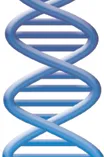 | CHAPTER 1 |
Can’t You Just Send My Clone to School?
The alarm is ringing in your ears, screaming like a banshee for you to get up. You cover your head with your pillow. If you just had a clone of yourself, you could send it to school in your place. Or could you? Even if scientists were cloning humans, you would never be able to use a clone as your substitute, because your clone would be born a baby and you would still be a teenager. As your clone grew, so would you. You and the clone would always be the same number of years apart.
A clone is a cell or organism that is genetically identical to the cell or organism from which it was made. Cloning is a form of asexual reproduction because all of the deoxyribonucleic acid (DNA) comes from the same parent. People often think of clones as being cranked out of factories just as cars are, in order to take over the world. But clones do not have to be copies of whole organisms. An organism is a living thing. It grows, uses energy, responds, reproduces, and has DNA in its cells. So scientists might clone just the DNA, or part of the DNA, from an organism. Or they might clone just one type of cell, some tissue, or even an organ.
Regardless of what is being cloned, the process always involves DNA. DNA contains the genes or chemical instructions that tell cells what to do, sort of like your parents telling you to get up in the morning. Each gene is one special type of instruction. Genes are found in DNA, DNA is found in chromosomes, and chromosomes are found inside the nucleus of a cell.
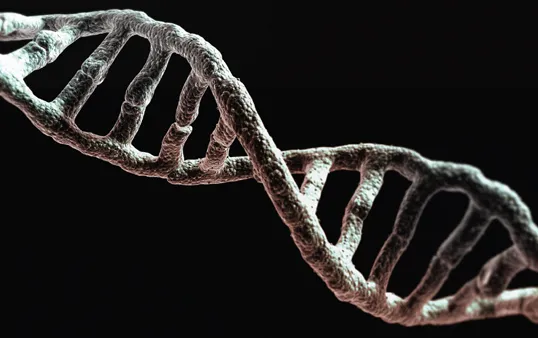
DNA holds the genetic instructions needed for an organism to function.
Scientists clone in order to make as many copies of genes, cells, tissues, organs, or organisms as possible, so that they have a number of samples to study. This way, they do not have to wait for natural processes to produce what they need in order to study diseases or develop new medicines. It is like looking for a needle in a haystack. If there is only one needle, it would take a while. But if there are thousands of needles, finding one would not take as long.
A BRIEF HISTORY OF CLONING
A German scientist named Hans Spemann created the first artificial clone in the laboratory in 1902. He used a human hair to split a two-celled salamander embryo into two individual cells. Each cell grew into the identical twin of the other. By doing this, he proved that each cell in a new embryo carries all the DNA needed to create a whole new organism.

■ An identical twin is a natural clone.
■ Cloning is a form of asexual reproduction that does not require two parents to produce young.
■ DNA contains the genes that carry the instructions for building new cells.
■ In nuclear transfer, the nucleus of a donor cell (with all of its DNA) is taken out of its own cell and put into a different cell that has had its nucleus removed.
■ The first clone of a mammal was a sheep named Dolly.
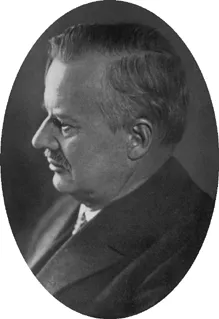
German scientist Hans Spemann performed the first nuclear transfers, thereby setting the stage for future work in cloning.
Spemann was also the first to perform a nuclear transfer using embryonic cells, opening the doors for later cloning work. In nuclear transfer, a nucleus is removed from one cell and put into a different cell. By the 1960s, scientists were using the adult body cells of frogs to perform nuclear transfers. Then in 1996, the world was introduced to Dolly. Created by Ian Wilmut and Keith Campbell at the Roslin Institute in Scotland, Dolly was the first mammal to be cloned from an adult body cell, using the frozen udder cell of an adult sheep. The udder is the bag-like sac that holds milk glands in cows, sheep, and goats. Although Dolly was a clone, she gave birth to a lamb named Bonnie in 1998. Bonnie was conceived naturally, proving that clones can breed and produce healthy young.
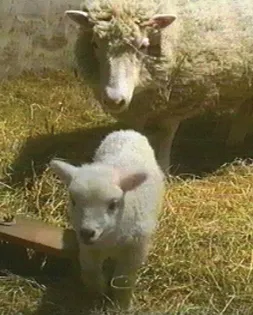
Dolly, the first cloned mammal, was able to mate naturally, giving birth to a healthy lamb named Bonnie.

Cloning may be hazardous to your health. Most clones do not survive. Scientists tried more than 270 times before Dolly the sheep was finally cloned. After suffering from health problems associated with premature aging, such as arthritis and pneumonia, Dolly finally had to be put to sleep She was only 6 years old. Most sheep live 11 to 16 years. Although scientists do not know if Dolly’s ailments were related to her cloning, some are still concerned that using DNA from adult cells makes the clone start out with older cells, so they age faster.
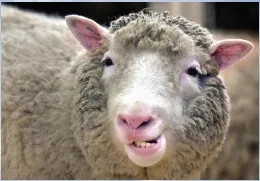
Dolly the sheep, before she died at age 6.
THREE TYPES OF ARTIFICIAL CLONING
Scientists have developed three different kinds of cloning: DNA, reproductive, and therapeutic. DNA cloning involves individual genes or groups of genes. Reproductive cloning produces whole organisms, and therapeutic cloning creates parts of organisms.
DNA Cloning
For DNA cloning, scientists use living cells, such as bacteria, to transfer genes from one individual into the cells of another. A bacterium has normal DNA, but it also has an extra piece of DNA called a plasmid. When the bacterium reproduces, it copies its normal DNA as well as its plasmid.
Scientists have learned how to use plasmids to add new genes to bacterial cells. First, scientists use a special chemical that acts like a pair of scissors to snip the DNA they want to clone from a plant or animal. Then they use another chemical to cut apart the plasmid, which normally forms a complete circle like a rubber band. When the new DNA is added to the cell, it joins with the broken plasmid.
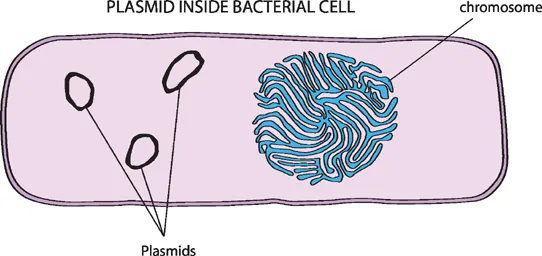
Most bacteria have one long, circular strand of DNA, as well as small extra pieces of DNA called plasmids.
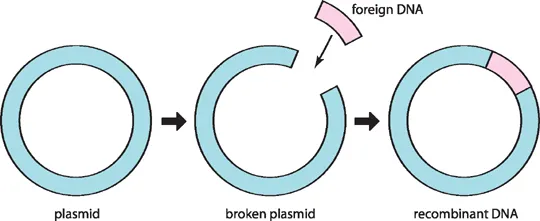
Recombinant DNA is prepared in the...
Table of contents
- Cover
- Title Page
- Copyright Page
- Table of Contents
- Chapter 1 Can’t You Just Send My Clone to School?
- Chapter 2 It Starts with a Cell
- Chapter 3 Cloning Humans
- Chapter 4 Is It Right?
- Chapter 5 What Does the Future Hold?
- Timeline
- Glossary
- Search Engine
- Index
- About the Author